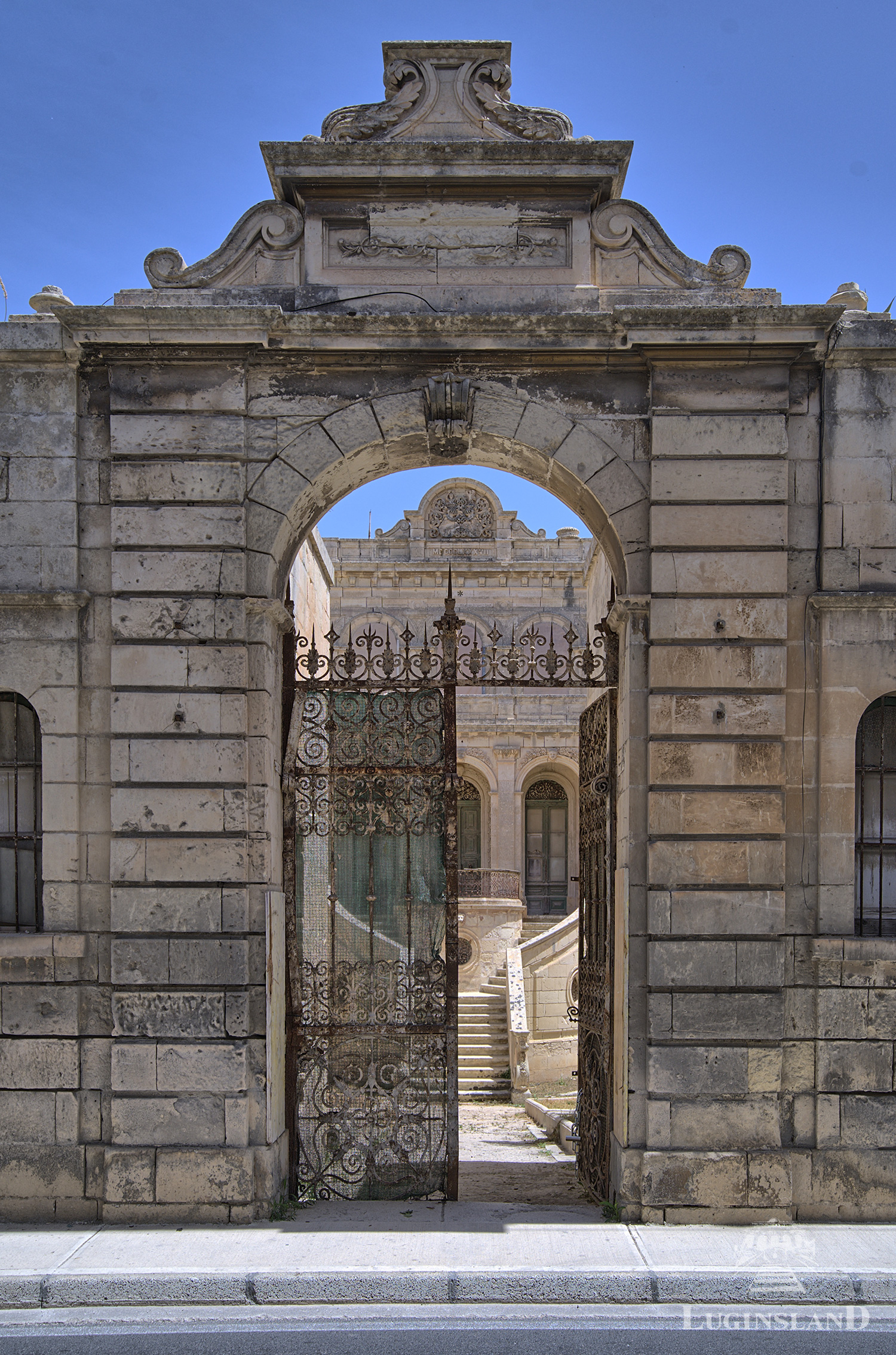HISTORICAL OVERVIEW

Villa Luginsland, view from the street
Image: Luginsland Limited ®
It is difficult to see Villa Luginsland from the street due to the surrounding wall. What draws attention, however, is the monumental gate with impressive medallions in the form of bas-reliefs with the inscriptions “Villa” and “Luginsland”.
The courtyard, with utility and technical buildings (coach houses) located on both sides, can be seen through the decorative gate.
In the central part, between the aforementioned buildings located on the left and on the right, there is a front garden, and in the background you can see a 2-storey building – the Villa, which at the end of the nineteenth century and the beginning of the twentieth century – until the end of the 1930s, was one of the most magnificent buildings of Malta in terms of architecture.
The following people are inseparable from the history of the Villa:
- Baron Maximilian Tucher von Simmelsdorf, owner of the Villa, German Consul in Malta, Chairman of the Association for Art of Commerce and Production, Chairman of the Philharmonic Society, Chairman of the Count Roger de Montgomery of Normandy Music Club, an art collector and one of Malta’s most influential people;
- Francesco Zammit – the architect of Villa Luginsland, a popular Maltese architect of the period;
- Giuseppe Cali – the author of the paintings in the Villa, the best Maltese painter of the period.
The history of the Villa in the above-mentioned period constitutes a part of not only the history of architecture but also the political and moral history of Malta itself. In the beautiful interiors of the Villa, which used to be the residence of the German consul, history was being created as, among many others, the baron’s guests included,:
- Wilhelm II – the Emperor of Germany and Prussia;
- Victoria of Schleswig-Holstein – the spouse of Wilhelm II Augustus;
- King Edward VII of England with his wife, Queen Alexandra (Queen of Denmark);
- King George V of England with his wife, Queen Margaret;
- King George VI of England;
- Queen Victoria of England;
- Maria Feodorovna – the Duchess of Denmark and the Russian Tsarina;
- Successive British governors of Malta: Sir Arthur Fremantle and Sir Leslie Rundle;
- Sir John Hopkins – the Admiral of the Royal British Fleet
It is difficult to prove whether Maximilian was also on an unofficial intelligence mission apart from the diplomatic one, but without any doubts he was fond of culture, art and architecture. It was during his term of office as the Consul that the building of the German Consulate located at 176 St. Christopher Street in Valletta was one of the most impressive buildings in the capital of Malta. (Currently the building houses the exclusive Rosselli hotel).
Maximilian’s love of beauty and architecture also demonstrated itself during the construction of Villa Luginsland.
The very choice of the architect proves that it was Maximilian’s intention to create a magnificent building from the very beginning. Maximilian probably did not find it difficult to persuade Zammit to cooperate as the latter was his wife’s cousin.
Baron von Simmelsdorf ran an open house where numerous cultural events took place. He organized one of the last events of this kind in January 1914, on the occasion of Emperor Wilhelm II’s birthday. Baron Von Tucher hosted an “at home” (at the Villa) reception for the German community in Malta.
It was very well attended by the Germans living on the island. This was practically the last official function of the German Consul General in Malta as the political situation in Europe rapidly continued to escalate. World War I was approaching, culminating in the declaration of hostilities between Great Britain and Germany on August 4, 1914.
Villa between 1914 and 1918
After the outbreak of World War I, during which Germany and England belonged to opposite camps, due to the growing tension in relations between Germany and England, at the request of Governor Leslie Rundle, the German consulate in Valletta was closed, and Baron Maximilian and Baroness Victoria von Tucher were asked to leave the island.
On July 3, 1914, on board the Austro-Hungarian SS F. Jos. Kiraly, the baron and his wife left Malta and, via Katana and Trieste, reached Germany.
On the journey, they were accompanied by Hermann Maempel, brother of the baroness.
The uninhabited property was looked after by Maltese members of the Maepel family who stayed on the island.
Villa between 1918 and 1932
When the baron, who most likely died in the first year of the war, i.e. 1914, had left Malta and the villa, its splendour died out.
In 1918, the Baroness returned to Malta and made attempts at reviving the cultural life in the Villa by organizing, among several other events, the wedding reception of Adelina Maempel (cousin of Baroness Maria (Maepel) Tucher von Simmelsdorf) and Edwin England Sant Fournier, a prominent Maltese architect.
At that time, the wedding was a significant social event in Malta and was widely commented on in the local press.
During this period, the Villa remained uninhabited. Oral accounts indicate that the family looked after the property after the baroness’s death. The family owned the keys to the Villa and used it occasionally when other family members were visiting Malta. Quite possibly, in order to reduce the costs of maintaining the property, the family rented the Villa, also to the British garrison command. During the World War II, the building was managed by British administration. In the meantime, places of refuge for several families were arranged in the building.
There is evidence that between 1953 and 1956, the Villa was used by a military garrison as a short-term accommodation facility for major guests of the garrison as well as doctors and families from a nearby military hospital. Panama Papers documents show that one of London real estate agents operating through a Panama based company tried to encourage managers of the Kaddafi family investment fund and a Russian businessman Alexey Bogdanchikov (son of the long-time president of the Oil company RosNeft) to purchase Villa Luginsland which stood empty and its condition deteriorating.
Villa from 1932 – up to the present day
The baroness died at the age of 76 in the Villa in Rabat on February 22, 1931. She was buried in the Santa Maria Addolorata cemetery. Hermann Maempel, Karl and Giovanna Maempel were also buried in the same family tomb. The Von Tucher family died childless.

